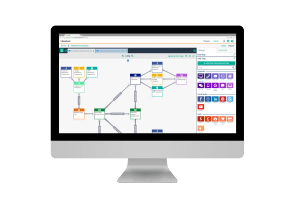Why Successful Customer Journeys in Travel and Hospitality Are Crucial
We know traveling can be stressful. Travel experiences begin long before the customer ever leaves their home. There are many points in the process that go wrong, many of which are outside the direct control of the brand. And we know that customers today have more options than ever to choose their own adventures. This means that if every experience isn’t properly vetted, a customer could be disappointed in their vacation or travel plan, or the businesses that they relied on to arrange their adventures. Despite these challenges, travel companies can improve those experiences across the board by developing comprehensive customer journeys! Companies can head off complaints and issues in a seamless manner to satiate or avoid those customer frustrations, and that can make all the difference. To take full advantage of customer journeys in travel, it’s critical to keep a few things in mind.
Travel is Stressful – Even When Everything Goes Right

Unfortunately, we have all felt painful travel experiences. Flights delayed. Layovers that are too long (or too short!). Appointments missed. Hotels that haven’t received our reservations from an aggregator. Uncomfortable seats. Being stuck on the tarmac. Unclear policies. Some of us have even been denied the presence of our comfort peacocks on our flights. If traveling wasn’t already tough enough, the risk of any of these things happening makes travel stressful.
Even well-managed trips can be overwhelming: Traveling long distances away from home base, sometimes to a place you’ve never been before can feel uncomfortable and usually present unpredictable challenges. If there are complications, you’re away from your usual network of support. Customers need to be able to rely on a travel company to make sure that things go smoothly.
At first glance, for a travel brand, these all seem to be troubles of a different sort. Weather, scheduling, design, copywriting, things breaking, and miscommunication are all unrelated, aren’t they?
Travel Is Always a Customer Journey

While it may seem outlandish to imply that the weather can be under your control, none of that matters to the customer. For the customer, they are solely focused on getting from A to Z. Despite what conventional wisdom says, the trip is about the destination and the journey in almost equal measure. If customers lose confidence in their successful arrival, then their experience will suffer. They cannot enjoy even those beautiful views, their most comfortable seats, or even the most well-trained staff.
It doesn’t help that, within travel, the stakes are so high. Whether it’s a business visit, a hard-earned family vacation, or a trip to see loved ones that precipitated the scheduled departure, frustrations inevitably run high when anything goes wrong. This will reflect poorly on your company. However, you can influence or even assuage even these negative experiences through personalized, responsive journeys.
Why Do Companies Need To Personalize Travel Experiences?
 As a travel brand, your customer’s journey with you begins long before they reach their vehicle. And, it ends long after they’ve left your care. How you navigate customers through the customer journey is in your control, even if customers themselves, the weather, or mechanical parts don’t cooperate! Before we break into a few key ways that customer journeys can transform travel journeys, consider the following:
As a travel brand, your customer’s journey with you begins long before they reach their vehicle. And, it ends long after they’ve left your care. How you navigate customers through the customer journey is in your control, even if customers themselves, the weather, or mechanical parts don’t cooperate! Before we break into a few key ways that customer journeys can transform travel journeys, consider the following:
Customer Journeys Require Consistent Execution

Imagine traveling on a budget airline. Let’s call them Spectre airlines.
Spectre’s seats are uncomfortable, and their booking process is full of opaque attempts to charge you for more things. Ultimately unless you travel with no bags, you pay only a little less than a more mainline brand. The seats won’t be as nice as a premium airline. Everything will cost more than it’s worth.
But you know this going into your trip. They’re Spectre. You’re ready for this experience.
You know that you’re getting what you pay for.
So when they make actually relevant offers in the pre-flight emails and provide actually useful information on policies prior to your flight, you’re impressed and even surprised. When the flight crew is fun and helpful, you can’t help but have your expectations exceeded. What you expected to be a negative flight experience turned out to be a great one.
Inconsistency Kills Customer Experience
Then the predictable happens. On your return flight, you get less lucky with communications. Before you booked, you looked at the hotel options and booked directly through Spectre’s website.
 Despite this, you still receive extra emails asking if you’d like to stay in the room you’ve already stayed in, even as you’re checking out from the hotel. In frustration, you delete the emails they’ve sent you, only to delete your boarding pass accidentally. Their website makes it difficult to find the tickets again.
Despite this, you still receive extra emails asking if you’d like to stay in the room you’ve already stayed in, even as you’re checking out from the hotel. In frustration, you delete the emails they’ve sent you, only to delete your boarding pass accidentally. Their website makes it difficult to find the tickets again.
Once you get to the airport, figure out the boarding pass situation, and get through security, you have trouble with the flight crew. The Spectre Airlines employee at the gate tells you that your bag that supposedly fit under your seat moments before suddenly has to be gate checked for an additional fee.
In a moment, everything that you had expected about this budget brand comes to fruition. Now you’re feeling frustrated, and it affirms that you should just pay the extra hundred dollars to fly Gamma Airlines next time. What went wrong on the brand side here?
Spectre obviously cares about customer experience. The first flight, where everything went right, wasn’t entirely by accident. Spectre made investments in an email system, in training their crew, and in the in-cabin experience. So what went wrong?
There was a disconnect between the customer journey and the systems that customers were interacting with. It made the positive experience seem like only a happy accident to the customer. The negative experience will not only linger longer but will actively set an expectation for inconsistency. This is the cost of failing to synch systems and channels together. Siloed communications and systems make delivering a consistent experience impossible.
What Can Brands Do to Personalize Travel Experiences?
Brands have 3 key opportunities to really shine every time. First, they can be proactive and reactive based on customer preferences. Then, brands can look at travel journeys as true customer journeys from start to finish. Finally, travel companies can and must connect their systems together in real time, so customers get consistent experiences at any point in their trip.
 What the best brands have realized is that regardless of industry, your true competition is no longer other brands in your vertical, but rather Digital Leaders. What do we mean by Digital Leaders? They’re businesses built from the ground up to be thoroughly interactive across web, apps, email, and ad tech. Think Uber, which manages their relationship with customers entirely within an app. Or Spotify, which intelligently recommends and plays music based on what people have already listened to.
What the best brands have realized is that regardless of industry, your true competition is no longer other brands in your vertical, but rather Digital Leaders. What do we mean by Digital Leaders? They’re businesses built from the ground up to be thoroughly interactive across web, apps, email, and ad tech. Think Uber, which manages their relationship with customers entirely within an app. Or Spotify, which intelligently recommends and plays music based on what people have already listened to.
If you can deliver on the following points, you will be able to compete effectively with those digital leaders at every turn.
Intelligent Travel Journeys Require Proactive and Reactive Customer Interactions
Most campaigns today are repetitive and impersonal. Ads show up on people’s social media feeds, in google searches, and in emails, but aren’t targeted to their behavior.
But consider what usually happens when that customer converts. They will be immediately placed in a new communications stream or worse, left in the old acquisition funnel. They’ll often receive communications that aren’t synched with their activities and will feel frustrated by the experience. In the Spectre Airlines example above, the marketing system and the pre-flight communications system weren’t in synch. Spectre actually was proactively communicating about hotel offers and flight information. But failing to connect their systems meant that the customer journey was disconnected and they failed to be reactive.
What can a travel brand do differently? Transform your push campaigns to live and listening journeys, reacting to customer demands, anticipating their needs, and identifying weak spots in your current customer experience.
Failing to Act in an Omnichannel Way Interrupts Brand Experiences

There are customer journey happening within your brand whether you are influencing that journey’s success or not. Customers don’t experience your brand as a series of tightly controlled touch points, or in silos. They don’t differentiate between Spectre Airlines’ call center, the emails they receive, and the agent at the gate. Instead, they see Spectre Airlines as a singular entity that they put information into and get information or services from.
The fact that those systems exist at all is why the first trip, where everything connected smoothly, was such a success. But because information isn’t actually being communicated between channels and because content, channel, and timing weren’t aligned, the problems struck on the second leg.
Transform your siloed, separate systems into a cohesive customer journey where every single customer communication online, on the phone, and in person is taken into account. This drives a streamlined, customer experience.
Orchestrating Real-Time Customer Journeys in Travel Contexts
What do we mean by real time?
When a customer books a flight, it should immediately trigger a series of actions, brought to fruition through a coherent journey plan. The day before the flight, send a reminder. A week before, ask if they need to rent a car. Whatever that cadence may be, it has to react to changing customer decisions.
 For a customer, it feels like the brand is paying no attention at all when you visit the website to rent a car, actually, sign up for a rental and yet the next day receive an email inviting you to complete the process! Perhaps the batch update was too slow, or perhaps the system connectivity we discussed earlier was not in place. Either way, the journey wasn’t adapted in real time.
For a customer, it feels like the brand is paying no attention at all when you visit the website to rent a car, actually, sign up for a rental and yet the next day receive an email inviting you to complete the process! Perhaps the batch update was too slow, or perhaps the system connectivity we discussed earlier was not in place. Either way, the journey wasn’t adapted in real time.
Travel journeys, like all customer journeys, require changing brand actions based on what the customer actually does. The fact is, that unless you’re able to personalize these touch points, the customer’s experience breaks down.
Transform your slow, batch-based processes to interact in real time and provide the best possible experience to your customers.
Incredible Travel Experiences Can Only Be Delivered Through Well Orchestrated Customer Journeys
By taking into account all customer experiences, and orchestrating them in a cohesive customer journey, brands can deliver incredible value to customers. When a brand looks at this entire customer lifecycle across every touchpoint, customers feel cared for, there is less friction between handoffs, and CX thrives.

What has your brand done to deliver a customer journey? Have you connected channels or done mapping or analysis? Perhaps a major CX initiative is underway as you read this. Almost every brand is thinking about Customer Journeys today. If your business isn’t keeping up with the times, we encourage you to consider reading Kitewheel’s eBook on How to Evaluate Your Customer Journey Maturity. Measure the maturity of your organizational journey strategy, and deliver a better experience for your customers in the process. If you haven’t invested in Customer Journey technology already, the time is now. Don’t miss your flight.


Please login to comment.
Comments